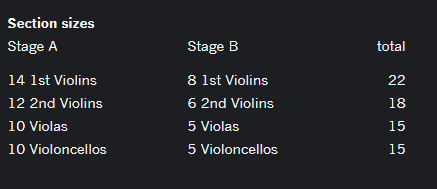Hey, what are you doing? I'm exporting the last files for Duality Strings Virtuoso for Herb. It's almost done.
Should we go over there and show him?
Yes, let's take a look.
Hi Herb, the samples of Duality Strings Virtuoso would be ready.
Okay.
In general, you were well in time.
Yes, it all turned out quite well this time.
Let's start with something unspectacular.
Seemingly unspectacular - Martellato.
Here the point is that the release samples are actually almost more important than the wavs themselves,
because I'm interested in the ending.
Usually the string players always play a final note and then they let it sound
and that's not supposed to be the case here. They should stay on the string with the bow,
which is quite normal in a phrase or a normal piece.
But it's in the DNA of a string player ... The last note should sound.
That was quite a challenge to get the musicians to do that.
But it worked well, so it sounds pretty good from what I've heard so far.
The idea behind it is that you can then play faster passages
without the reverberation produced by the instruments building up,
but the reverberation that you need to make it sound good is still there.
Yes, sounds great!
Works great.
Let's take a look at the very quiet ones.
Great. Did you have to do a lot of cleaning with the releases of the martellatos, or were the players very disciplined?
No, that was actually quite okay.
Okay. Well, then maybe we'll take a look at the arpeggios.
My favorites are the fifth arpeggios.
And were you always able to use the fully played length of the arpeggios, or did you have to remove something?
We were actually able to use almost everything with most of the samples.
We had to correct some samples a bit, but the majority were wonderful.
And of course the
timing is important. It shows
if you hold it for a long time and then crossfade, you can see whether they remain synchronized. Let's see.
Awesome!
Yes, the musicians hated me.
In the high register ... because usually you always play it where you can reach everything well.
But from the fifth position upwards it gets really tight.
It becomes difficult.
But I said we need it in all keys. They said it doesn't exist normally.
And then, well ... After a lot of back and forth, they did it.
But they said if they'll ever see this in the sheet music of a live session they'll crucify me

Maybe we should mention this in the manual: Please don't write for live orchestra in the upper register!
What is your favorite arpeggio?
Hmm ..
Dominant 7th I found quite nice.
And the composition is finished.
Let's also check the loop sync here.
Totally fine.
So, up to the, I'd say, up to the G, up to the fifth above the open strings, it's fine.
And having to play the top notes was always crazy. Like this ...
We haven't had any great difficulties here.
Now let's take a look at how it reacts when you turn up the speed here.
It's so interesting that the time-stretching always works quite well as far as the players might be able to play it in real life.
And then it gets unnatural because you've never heard it that way. Because it's no longer physically possible.
There are limits somewhere.
That works.
Super. The falls, I always call them falls. They are actually down bends ...
...at the end.
They have a history...
I thought by myself, I finally want to have an articulation that's like what David Arnold did with the strings in Stargate,
to create this oriental character.
Sounds awesome.
Great, and now the longer ones.
I think they work best in the lower register and you don't immediately get the feeling that it's so disco-like,
that it's somehow slightly off-key.
Because they sound exactly right.
Good. Stargate here we come.
They were also really cool to edit.
You also notice that these things are also a lot of fun for the musicians ...
Let it bounce!
Super. Cool. And then, of course, we have all the chromatic modules as a major extension.
So far we haven't heard of any problems that we need to correct.
I shouldn't play one after the other so quickly.
You can tell that they are challenged. But that's good.
Okay, but that sounds good too.
Sounds good too.
Let's play the very slow glissandos.
Up or down? Take your pick.
I think with these upwards is cooler.
Okay.
But now I still want to hear it downwards.
But let's do that with the tremolo.
That's where you see the difficulty with the really long, slow notes, that they have to remain reasonably synchronized.
But then again, that's what makes it so appealing, that
they are not always one hundred percent in tune.
How does that sound in two voices?
They are even the same length.
We looked at that, yes.
So if there were deviations, you made sure that they didn't have any overhangs or things like that?
The rough stuff in any case.
Great. Well, I'd say listen through all of it once again and then get it out, right?
Great work!
Thank you very much!
Thank you Patrick!
And?
I think it works for him!









